Full-Spectrum Lighting for Vibrant Pet Terrariums
Bright, full-spectrum lighting can transform your pet terrarium into a vibrant haven!
Take it from me and my axolotl, Mr. Wiggles. His color danced like a rainbow after I upgraded the lighting in his tank! He went from drab to fab, and boy, it was a sight to behold. The right lighting is crucial for our pets’ health, plus it helps plants flourish. I share tips and tricks related to pet care over at my blog, ExoTails.
Let’s make sure Mr. Wiggles—and your pets—shine bright!
A Day in Mr. Wiggles’ Life
One afternoon, I noticed Mr. Wiggles lounging under his new light.
It reminded me how vital proper lighting is for energy and mood. Seeing him thrive made all the effort worth it! The right light doesn’t just brighten things up; it creates an environment where our pets can truly flourish.
Quick Takeaways
- Full-spectrum lighting closely imitates natural sunlight, promoting healthy behaviors and preventing health issues in reptiles.
- Selecting appropriate UVB bulbs is essential for calcium absorption and overall reptile well-being.
- Create distinct light and heat zones in the terrarium to cater to your pet’s natural basking and retreating instincts.
- Maintain a consistent 12-hour light and dark cycle to support your pets’ circadian rhythms and well-being.
- Use light measurement tools to ensure adequate intensity for both reptiles and plants, optimizing their health and vibrancy.
Understanding Full-Spectrum Lighting for Reptiles

When it comes to lighting your reptile’s terrarium, one might wonder why full-spectrum lighting is such a big deal.
Well, let me tell you: UVB benefits and UVA importance are vital for your scaly friends! Full-spectrum lighting mimics natural sunlight, helping reptiles see their environment vividly and promoting healthy behaviors. Additionally, proper lighting ensures that reptiles receive adequate UVB exposure, which is essential for preventing health issues like metabolic bone disease. Moreover, having the right lighting conditions can enhance plant growth in the terrarium, allowing both your reptiles and plants to thrive.
Plus, it’s not just about the reptiles. It supports plant growth, ensuring a beautiful setup that even I—ever the exotic pet enthusiast—love!
Choosing the Right Bulbs for Your Terrarium
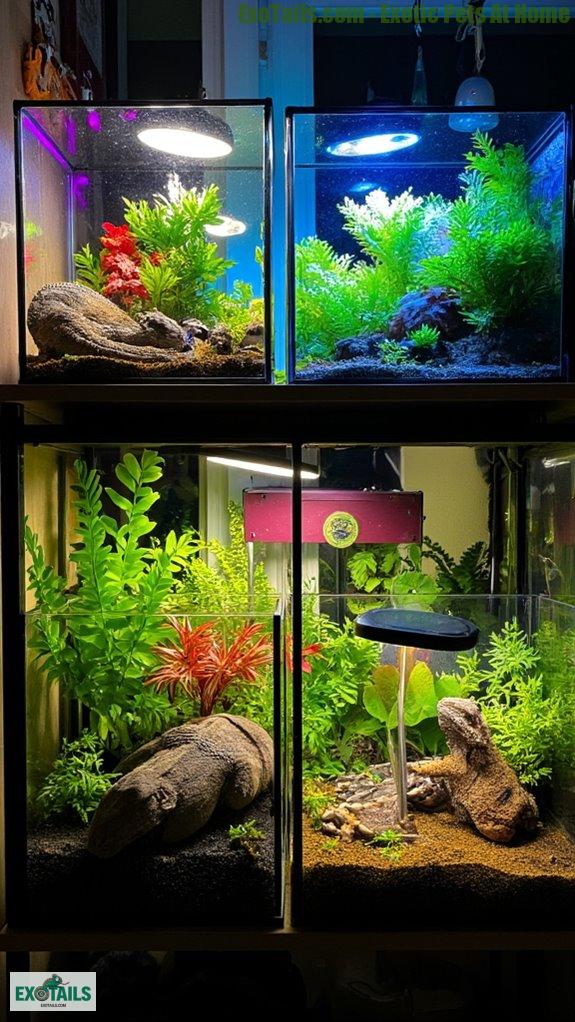
Full-spectrum lighting isn’t just a fancy term; it plays an important part in creating a thriving habitat for your reptiles and plants alike.
When choosing bulbs, consider wattage carefully—too much heat can turn your terrarium into a sauna! I always recommend LED bulbs; they’re energy-efficient, create minimal heat, and come in a rainbow of colors. Additionally, make sure to research specific requirements for your reptile species, as many need UVB lighting. Quality UVB lighting is crucial for calcium absorption and preventing metabolic bone disease.
Plus, they last longer, which keeps your wallet happy. Fluorescent bulbs can offer essential UVA/UVB light, too.
It’s all about matching your light choice with the needs of your exotic pets. After all, a happy pet equals a happy keeper, right?
Creating Effective Light and Heat Zones

Creating light and heat zones may sound like a complex science experiment, but trust me, it’s simpler than it seems!
When setting up your terrarium, prioritize light placement to create effective temperature zones.
A basking zone with a heat lamp mimics the sun, letting your pet soak up warmth and then retreat to cooler areas as needed.
This setup mirrors their natural instincts! Additionally, ensuring a balance of essential lighting and heating will promote your pet’s overall health and well-being.
Optimizing Light Duration for Daily Cycles

Optimizing light duration for your pet terrarium is like giving your little buddies a gentle wake-up call each day, ensuring they’re ready for action.
Nailing that 12-hour light and dark cycle supports a healthy circadian rhythm, which sounds fancy, but it’s just your pets’ way of keeping their internal clocks in check. By mimicking natural cycles, you can enhance their overall well-being.
And hey, don’t forget to adjust based on their species requirements!
Automatic timers can take the guesswork out, so they won’t be confused when you inevitably forget.
After all, I want my terrarium to be the happiest place, not a disco party at midnight!
Balancing Plant and Animal Lighting Needs
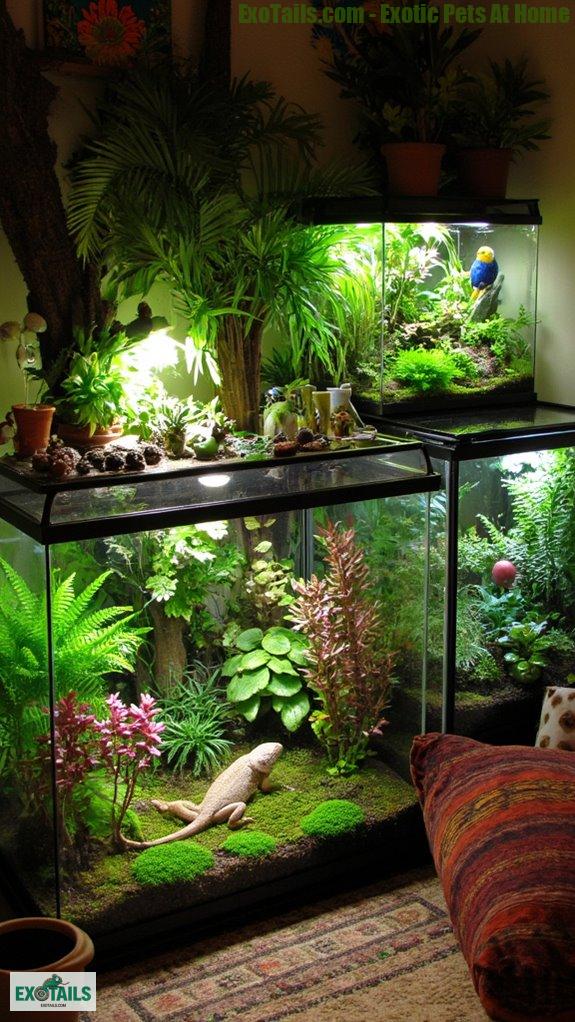
When it comes to keeping your terrarium thriving, balancing the light needs of both your plants and animals can feel like a juggling act.
You’ve got to take into account those plant light requirements—low-light plants don’t need a spotlight, while high-light species crave the limelight!
Meanwhile, your critters might’ve specific animal light preferences that differ.
I love creating vibrant homes for my exotic pets, so I know striking this balance is key.
Full-spectrum LEDs can be your best friend, offering the right spectrum for everyone without burning the house down!
Monitoring Light Intensity and Quality
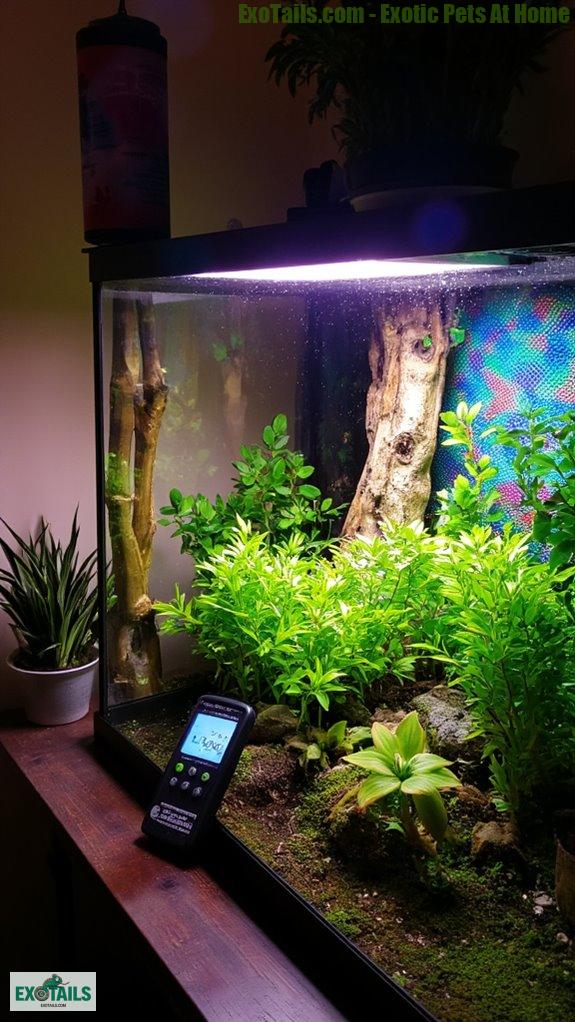
Understanding light intensity and quality is a bit like tuning a musical instrument; you want everything in harmony for a vibrant terrarium.
I rely on light measurement tools like lux meters and SolarMeters to verify I’m meeting illumination standards. It’s vital to know that substrate levels should be around 1500 to 3400 lux, while mid-height should reach 3500 to 7400 lux.
Plus, keep in mind that UV lighting is imperative for reptiles—who wouldn’t want their scaly friends to thrive? Monitoring these levels means a happy critter, vibrant plants, and a stunning setup that’ll make your friends say, “Wow!”
Tips for Adjusting and Maintaining Your Setup
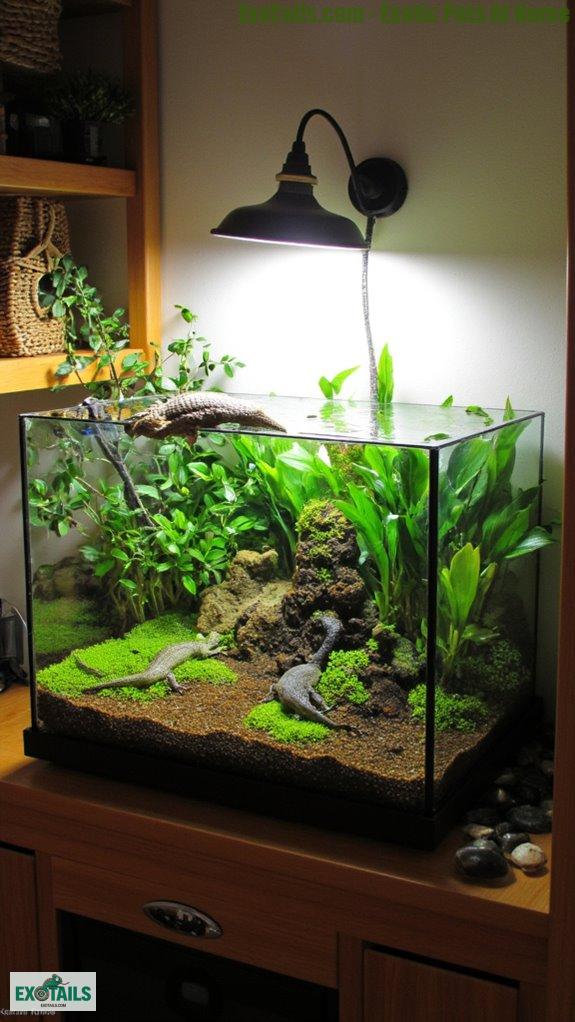
To keep your terrarium thriving, adjusting and maintaining your lighting setup is essential—think of it as giving your plants and reptiles a daily dose of sunshine therapy!
For effective light maintenance, regularly check your bulbs and fixtures, ensuring they’re clean and positioned correctly.
Keep in mind, fixture placement can make or break your light distribution—don’t let your plants play favorites!
A good rule of thumb? Aim for a consistent day-night cycle of about 12 hours.
By mimicking natural conditions, you’ll create a cozy haven for your pets and plants.
Trust me, they’ll thank you with vibrant colors and happy wiggles!
My Axolotl at home
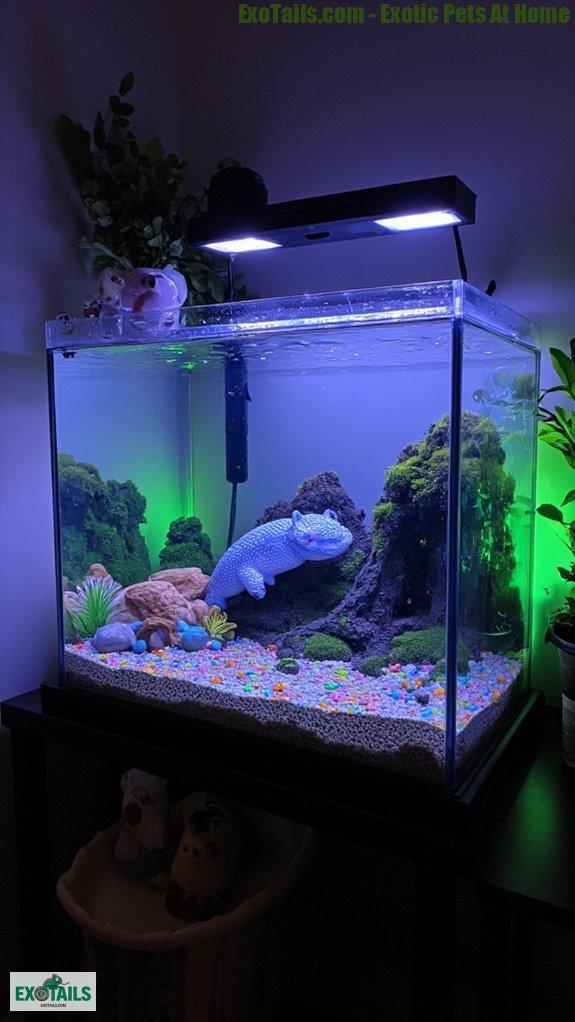
My axolotl, a whimsical little creature straight from the underwater domains of Mexico, has brought so much joy into my home.
Watching its quirky habits never fails to amuse me!
In my carefully designed tank setup, I’ve guaranteed dimmable LED lights keep the vibes mellow.
Axolotls prefer a cozy, murky environment, so I also added plenty of hiding spots.
Did you know they thrive better with a consistent day/night cycle?
I use a timer to mimic their natural habitat.
As someone who adores exotic pets and home decor, ExoTails grew from my joy in creating a balanced oasis for my aquatic friend!
References
- https://talis-us.com/blogs/news/create-the-perfect-reptile-light-setup-for-your-terrarium
- https://thriveecosystems.com/blogs/advice-and-everyday-activities/unlocking-the-secrets-of-terrarium-lighting-a-comprehensive-guide-to-choosing-high-spectrum-lighting-for-optimal-plant-and-animal-growth
- https://bantam.earth/terrarium-lighting/
- https://www.zillarules.com/articles/the-ultimate-guide-to-lighting-and-heating
- https://terrariumtribe.com/lighting-for-terrariums/
- https://nanoluxtech.com/can-you-use-led-grow-lights-for-reptiles/
- https://reptifiles.com/plant-lights-for-bioactive/
- https://www.visionproducts.us/blog/the-significance-of-uva-and-uvb-reptile-lights/
- https://www.beardeddragon.org/threads/full-spectrum-lighting.235017/
- https://talis-us.com/blogs/news/achieve-optimal-lighting-in-your-reptile-terrarium







